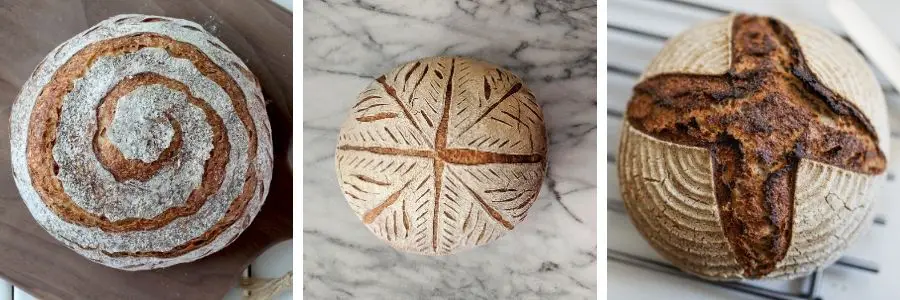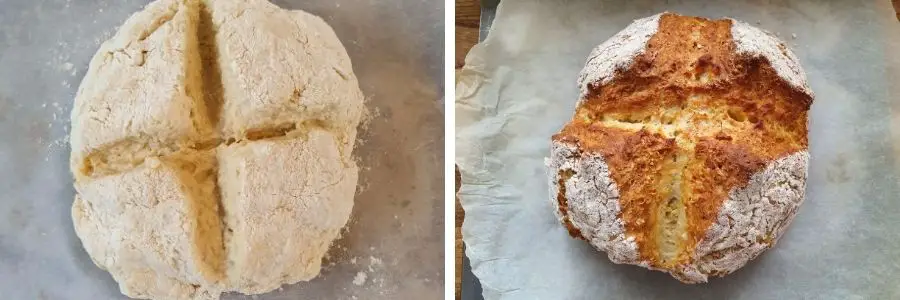Many types of bread are leavened (risen) with yeast, but if for some reason you can’t eat yeast or would prefer not to then what are your options for bread which doesn’t contain yeast? The good news is there are many options when it comes to yeast-free bread.
Below are just some varieties which can be made without using yeast as a raising agent:
- Yeast-free sourdough bread
- flatbreads such as wraps or chapatis
- Irish Soda bread
- Australian Damper bread
- Yeast-free banana bread
Read on to find out more about bread which don’t contain yeast and what ingredients or techniques are used to raise the bread instead. I’ll also explain why some bread doughs generally need yeast to rise.
Why do certain breads contain yeast?
Yeast is a microorganism which is used in many types of bread recipes and also for brewing beer.
When it’s used in bread dough it helps to create a fermentation process and produces gas bubbles which help the dough to expand and grow.
Yeast comes in either a fresh or dried form and it’s generally the best way to produce a higher rise in bread than other leavening (rising) methods.
There are other options though, and I’ll go on to explain them next.
Yeast free sourdough bread
Sourdough is an artisan and very pure way of making bread that doesn’t contain any yeast.
You can buy sourdough in speciality bread shops, market stalls, deli’s and some supermarkets or you can make it from scratch at home.
If you have a yeast intolerance, it’s still worth checking the ingredients as some supermarket bread may still contain some yeast and the sourdough element is used as a flavour rather than a rising agent.
Where sourdough is made properly it’s made using a sourdough starter which is usually made from flour and water, although in some cases additional ingredients such as apple may be added to boost the fermentation process.
The sourdough starter is then fed with more flour and water over time and becomes a bubbly lose dough-like ingredient which is added to dough ingredients and helps the dough to rise.
In many cases, sourdough bread can be made using just three ingredients, which are flour, water and salt – although additional ingredients can be added.
The rising process of sourdough takes much longer than bread which is risen using yeast. This longer process produces a crusty bread with a unique sourdough flavour.
If you can’t eat yeast, sourdough is a good replacement for yeast type bread and you can use it in many ways, including:
- Sandwich bread
- Toast and toasted sandwiches
- As a side dish to a main meal
- For croutons
and many more.
You can also use the sourdough process to make other yeast-free bread types:
- Sourdough focaccia style bread
- Sourdough baguettes
- Sourdough garlic bread
- Pizza bases
- Sourdough ciabatta
You can also use various types of bread flour to create a sourdough starter and within the dough ingredients or you can experiment with a mix of flour types. There really are unlimited options when it comes to using the sourdough process.

Yeast-free flatbreads
This might sound like I’m stating the obvious, but some flatbreads get their ‘flat’ look because the dough which is used to create is not allowed to rise before it’s used.
If you can’t eat yeast for a specific health reason and you’re looking to buy yeast-free flatbread style bread, make sure you check the ingredients because there are many flatbreads which generally use yeast in the recipe.
Flatbreads which usually contain yeast are:
- Naan bread
- Pitta bread
- Pizza
- Sandwich style flatbreads
- Focaccia
As a general rule, where a bread type has a puffed-up type look, then it probably contains yeast.
Flatbreads which don’t usually use yeast in the recipe are:
- Chapatis
- Sandwich or tortilla wraps
- No-yeast flatbread
These flatbreads are quick to make and are usually made from just flour, yeast and salt. No rising is required and in most cases, these types of flatbread are cooked in a pan rather than an oven.
TIP: Not sure if you have all the necessary bread baking equipment at home? Check out my recommended picks below (Amazon links):
-
- Scale: Nicewell 22lb Digital Kitchen Scale
- Mixing Bowls: OXO Stainless Mixing Bowls Set
- Pastry Scraper: OXO Stainless Pastry Scraper
- Loaf Pan: OXO Non-stick Loaf Pan
- Kitchen Thermometer: ThermoPro Digital Thermometer
- Stand Mixer (optional): Kenwood Kmix Stand Mixer
Yeast-free Irish soda bread
Irish soda bread is a quick and easy yeast-free bread which is made using baking soda (also known as bicarbonate of soda) as the rising agent in the dough.
soda bread dough doesn’t need to be given time to rise, you just combine the ingredients, shape and bake.
You can make soda bread using white or brown flour and you can add more flavours to the dough such as cheese and onion.
Soda bread is often made using buttermilk as the liquid element of the bread and this helps to create a soft and creamy looking texture.
It’s quite a heavy bread, but it does work well as a side dish to soup and stews.
Find out how to make Irish Soda bread via the link below:

Australian Damper Bread
Australian damper bread is very similar to Irish Soda bread, but it’s usually made with a self-raising flour as the leavening agent rather than baking soda.
Damper bread was traditionally baked in a fire, so it’s a perfect bread to try on a camping trip inside a dutch oven (or stoneware style) lidded pot or pan.
Like Irish Soda bread, you can add additional flavours to make the bread more interesting and flavoursome.
Yeast-free banana bread
Most banana bread recipes are yeast-free, although there are some recipes out there which do use yeast – the majority don’t.
Banana bread is more of a moist cake-like recipe which is usually leavened using baking powder or self-raising flour.
You can add extra ingredients to banana bread to create more flavour and texture, including nuts, dried fruit and spices to create a warm flavour.
Try one my yeast free banana bread recipes via the links below:
Also find out, what is banana bread eaten with.
You might also like…
I hope this post has helped you to find out more about yeast-free bread and maybe even try making your own.
You might also like the following posts:
Types of bread – the ultimate guide of bread from around the world
